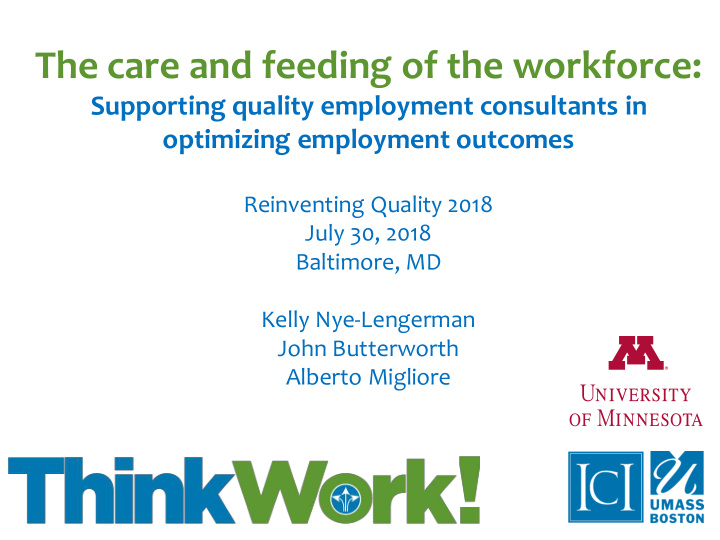



The care and feeding of the workforce: Supporting quality employment consultants in optimizing employment outcomes Reinventing Quality 2018 July 30, 2018 Baltimore, MD Kelly Nye-Lengerman John Butterworth Alberto Migliore
Today’s Agenda Why are we here (What’s the issue)? What are we doing about it? What have we learned from research? Where we are going? Live from the field-- SEEC
Number in Employment and Day Services 700,000 632,000 600,000 500,000 Non-work 312,448 400,000 300,000 200,000 Facility-based work 100,000 Integrated employment 0 1990 1993 1996 1999 2004 2008 2012 2016 Source: ICI National Survey of State IDD Agencies: www.StateData.info
Holistic Perspective
Employment consultants are key “…Regardless of the job seeker’s level of motivation, skill, experience, attitude, and support system, his or her ability to get a job will often depend on the effectiveness of employment specialists. Simply stated, if they Employment consultant are good, job seekers get jobs. If they are not, the barriers to employment for job seekers can become insurmountable…” Luecking, R. G., Fabian, E. S., & Tilson, G. P. (2004). Working relationships: Creating career opportunities for job seekers with disabilities through employer partnerships. Baltimore: Paul H. Brookes., p. 29 5
What is an Employment Consultant ? Professionals who assist job seekers with disabilities explore, find, and maintain employment. Employment navigator Business consultant
What’s the problem? Extensive literature on effective support practices BUT Limited knowledge about fidelity of implementation (Not counting MH)
Key goals: What do employment consultants do? What is the relationship of practice to outcome? How can we provide implementation support ? Data-based feedback Reflective practice Microlearning, mobile learning, personalized learning 8
Vision Clear practice guidelines Flexible model that accounts for variations in individual preference and needs A scalable approach to improving implementation of employment supports
How are we researching ECs? Employment consultants (EC) survey (2009) Training & Mentorship intervention (2010-2011) Pilot activity log (2013) Community Rehabilitation Programs survey (2014) Employment consultant interviews (2015) Daily survey (2016) Daily survey intervention study (2017-2018) Identify Develop Collect & Develop Application critical design gather data findings to practice questions
Clear practice guidelines
Quotes from the field “…I’ ve got to establish some ground rules from the beginning: number one ground rule is ‘ I ’ m not here to find you a job. You and I together as a team are going to find a job ’…”
“… So always listen to the individual first and make sure that their voice is heard because it's very easy for that voice to get lost amongst agencies, the family, the state, the employer, if they're employed, other various community members and team members … Their voice needs to be weighed more than any other. ”
What do employment consultants do? • What primary support activities are implemented? • Who is the primary interaction with? • Where do these interactions take place? Once each work day, at a random time, June 2016 to May 2017
Participants 61 employment consultants in 37 employment programs, in 17 states. 63% retention rate. 90% daily response rate. Other project activities Baseline and quarterly surveys. Tips, tools, resources on smartphones. Monthly community of practice and performance feedback 15
WHAT primary support activity? (N=61 ECs, Jun 2016 to May, 2017) NOT employment- related, 15% Getting to know job 6% seekers Administrative Supports leading Finding jobs 13% activities, 29% to hire, 30% Other supports (2.4 hours per day) 11% before hire Supports after hire (e.g. job coaching), 26% 16
NOT employment- Ask the audience related, 15% Getting to know job… 6% Administrative activities, 29% Supports leading to Finding jobs 13% hire, 30% Other supports before… (2.4 hours/day) 11% Supports after hire (e.g. job coaching), 26% Is 30% of time spent in supports leading to hire too much, not enough, or just right? What are some other strategies to increase time in supports leading to hire? 17
WHERE Other, 11% In a vehicle, 5% Office, 41% Businesses, 18% Community settings, 24%
WHO Who else? 5% Who? 69% 17% 15% 8% 12% 10% 6% 3% Person Business Family, None Other I support personnel friends 19
Finding jobs Job negotiation, 2% Other , 9% Cold calling , 12% Browsing ads , 38% Networking, 26% Researching, 13% 20
Job negotiation, 2% Other , 9% Ask the audience Browsing Cold calling , 12% ads , 38% Networking, 26% Researching, 13% Is 38% of time spent browsing ads too much, not enough, or just right? What are some other strategies to find jobs? 21
Bersin & Associates 22
Microlearning, mobile learning 23
Performance support 24
Participants said … I enjoy the feedback from other employment specialists, I enjoy the videos and online training …
Where are we going from here? • Make the daily survey app publicly available; Use the closing screen to provide data-based personalized resources (Tips, tools, videos) • Investigate how funding, data collection, employment consultant practices, and the literature about effective supports all align. • Investigate how employment consultants make decisions about the supports that they provide to job seekers. 26
Key take away points : 1.Importance of reflecting on implementation. Time spent…: • on supports that lead to hire • in businesses • interacting with employers • connecting with family members 2.Including data in decision making. 3.Micro, mobile, personalized learning as a support of traditional training.
Implications for States Promote capacity-building through: Provider transformation. Employment programs’ effectiveness. Employment consultants’ excellence. Streamline administrative tasks. Use funding to shape services. Promote innovation.
Questions? www.ThinkWork.org/strand2 Kelly: knye@umn.edu John: john.butterworth@umb.edu Alberto: alberto.migliore@umb.edu Data for this presentation are from a project carried out in partnership with Kelly Nye-Lengerman and Amy Gunty at the University of Minnesota. Thank you also to our colleagues at the Universty of Massachusetts Boston for their contribution: Oliver Lyons, Jill Eastman, Paul Foos, Jennifer Bose, Melanie Jordan, Mark Hutchinson, Allison Cohen-Hall, Lara Enein-Donovan, and Uchenna Nwangwu.
Recommend
More recommend